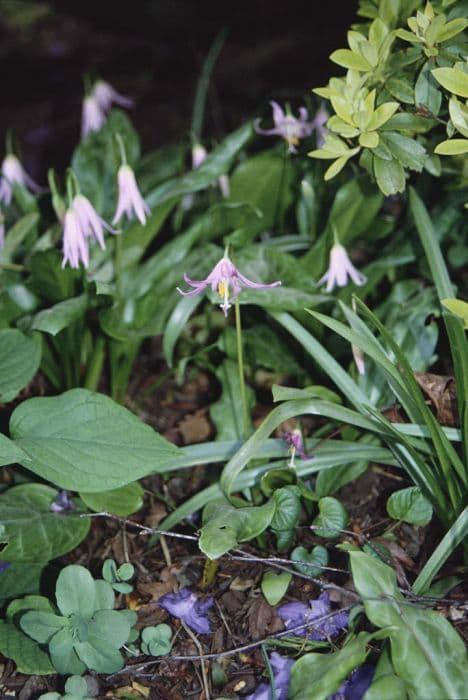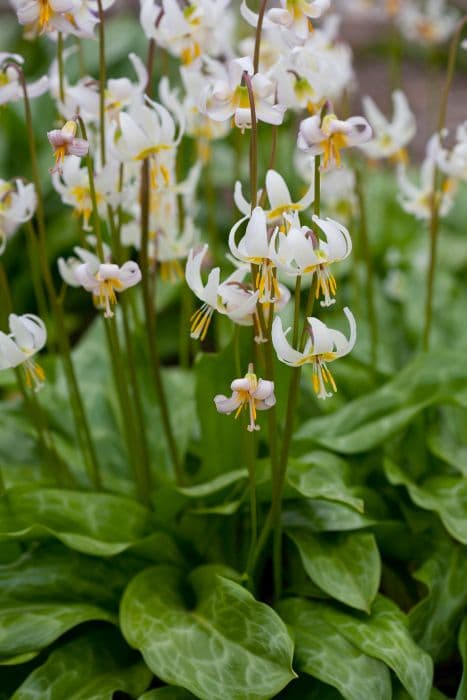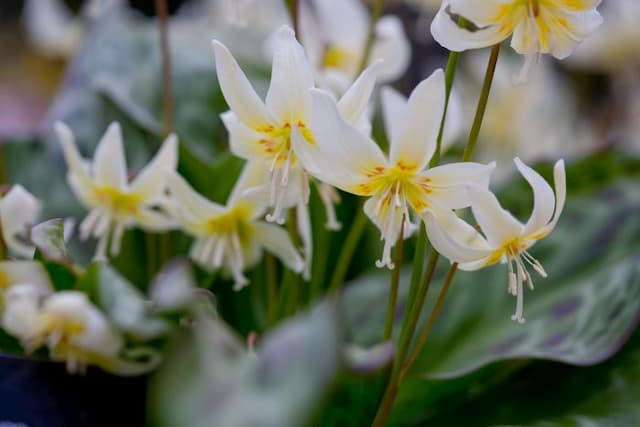Pink Fawn Lily Erythronium revolutum

ABOUT
The plant known as pink fawn lily is a charming and graceful species that typically heralds the arrival of spring with its striking features. It boasts a pair of mottled leaves that emerge from the ground, providing an attractive backdrop for its flowers. The leaves are often broad and glossy with a marbled pattern of green and brown, which gives them a distinctive and ornamental appearance. As the plant matures, it produces its iconic flowers – a true spectacle of the species. These blossoms are typically a deep to bright pink color, and they exhibit an elegant hanging posture. With petals that reflex backwards, giving them a swept-back appearance as if fluttering in the breeze, the flowers exude a delicate beauty. They are trumpet-shaped and often have a darker pink or yellowish base, sometimes adorned with fine spots or streaks that add to their appeal. The pink fawn lily's bloom is not only a visual treat but also serves as an attraction for pollinators visiting the plant during its flowering season. This perennial plant is a part of the lily family, and it carries the charm and allure that lilies are known for, albeit in a smaller and more understated form compared to some of its more ostentatious relatives. It is a testament to the subtle beauty that can be found in wildflowers and native plants that grace woodland areas and garden spaces alike.
About this plant
 Names
NamesFamily
Liliaceae
Synonyms
Pink Fawn Lily, Mahogany Fawn Lily, Coast Fawn Lily, California Fawn Lily, Western Trout Lily, Redwood Fawn Lily
Common names
Erythronium revolutum.
 Toxicity
ToxicityTo humans
The Pink Fawn Lily is not typically considered toxic to humans. However, as with any plant, individual allergies or sensitivities can cause adverse reactions in some people. Normally, ingestion of plant parts is not associated with serious health risks, but caution should always be exercised when dealing with wild plants, as mistaken identity may lead to ingesting toxic species.
To pets
The Pink Fawn Lily is also not known to be toxic to pets. However, it is always prudent to prevent pets from eating plants, as they could have individual reactions or there could be potential risks not well documented. If a pet were to ingest this plant and show any signs of distress, such as vomiting, diarrhea, or unusual behavior, it is advisable to consult a veterinarian.
 Characteristics
CharacteristicsLife cycle
Perennials
Foliage type
Deciduous
Color of leaves
Green
Flower color
Pink
Height
1 foot 4-16 inches (30-40 cm)
Spread
1 foot 4-16 inches (30-40 cm)
Plant type
Bulb
Hardiness zones
5
Native area
Northwest America
Benefits
 General Benefits
General Benefits- Aesthetic Appeal - Erythronium revolutum, commonly known as the pink fawn lily, adds visual interest to garden spaces with its distinctive nodding flowers and attractive mottled foliage.
- Pollinator Attraction - The pink fawn lily is known for attracting bees and other pollinators, supporting local ecosystems and benefiting other plants in the vicinity.
- Naturalizing - Pink fawn lilies can spread over time and create naturalistic woodland gardens, enhancing the landscape with minimal maintenance.
- Shade Tolerance - As a woodland plant, Erythronium revolutum thrives in shaded areas where other plants might struggle, offering gardeners more planting options.
- Seasonal Interest - These plants have a specific flowering time in the spring, providing seasonal interest and enhancing the year-round appeal of gardens and natural areas.
 Medical Properties
Medical PropertiesThis plant is not used for medical purposes.
 Air-purifying Qualities
Air-purifying QualitiesThis plant is not specifically known for air purifying qualities.
 Other Uses
Other Uses- Erythronium revolutum, commonly known as pink fawn lily, can be used in natural landscaping and woodland garden settings, providing a delicate visual appeal beneath deciduous trees.
- The pink fawn lily's ability to thrive in shade makes it a good candidate for underplanting in orchards where sunlight is filtered through the tree canopy.
- The plant is sometimes used in symbiotic planting schemes as it can form a beneficial relationship with certain types of fungi, improving soil health.
- Pink fawn lily's dried leaves can be used to create a natural yellow dye for fabrics and yarn, providing a sustainable coloring option.
- The bulb of the pink fawn lily can be ground to a paste and used as a natural adhesive or binder in traditional crafts.
- Due to its attractive appearance, the plant is often used for educational purposes to teach botany and ecology in schools and nature programs.
- The nectar-rich flowers of Erythronium revolutum could be used to provide a food source for beneficial insects, supporting local biodiversity.
- Photographers and artists may utilize the pink fawn lily as a subject in their work, capturing its ephemeral beauty in various forms of media.
- Culinary enthusiasts might experiment with the plant's petals as an edible garnish for salads and desserts, once ensuring they are safe and not treated with harmful chemicals.
- The plant's seed pods can occasionally be used as a natural source of seeds for propagation by hobby gardeners interested in growing native plant species.
Interesting Facts
 Feng Shui
Feng ShuiThe Erythronium revolutum, commonly known as the Pink Fawn Lily, is not used in Feng Shui practice.
 Zodiac Sign Compitability
Zodiac Sign CompitabilityThe Pink Fawn Lily is not used in astrology practice.
 Plant Symbolism
Plant Symbolism- Beauty: Known commonly as the "Pink Fawn Lily," Erythronium revolutum is often associated with delicate beauty due to its attractive pink flowers and graceful appearance.
- Resilience: As a wildflower that emerges in spring, often in challenging conditions, the Pink Fawn Lily symbolizes resilience and the ability to thrive in adversity.
- Renewal: The emergence of the Pink Fawn Lily after winter signifies renewal and the cyclical nature of life, often representing new beginnings.
- Delicacy: With its thin stems and tender petals, the Pink Fawn Lily can represent fragility and the delicate balance in nature or life.
 Water
WaterThe Erythronium revolutum, commonly known as the Pink Fawn Lily, should be watered deeply once the top inch of soil feels dry to the touch, which usually means about once a week during active growth periods. It is essential to ensure that the soil remains moist but not waterlogged. In terms of quantity, during the active growing season, you should apply approximately one gallon of water per square foot every week. During the dormant season, watering should be reduced significantly to prevent bulb rot. It's also important to provide water at the base of the plant to avoid wetting the foliage, which can lead to fungal diseases.
 Light
LightPink Fawn Lily flourishes in dappled sunlight under the canopy of deciduous trees or in a spot that receives morning sun and afternoon shade. Avoid exposing it to the harsh afternoon sun, as this can cause leaf burn. The ideal lighting conditions mimic the woodland environment where they naturally grow, so placing them in a similar environment in your garden is optimal.
 Temperature
TemperaturePink Fawn Lily prefers a temperate climate and will grow best in temperatures that range from 40 to 75 degrees Fahrenheit. However, these hardy plants can tolerate temperatures down to about 20 degrees Fahrenheit. The ideal growing conditions would include daytime temperatures of about 65 degrees Fahrenheit with cooler nights to mimic their native woodland habitat.
 Pruning
PruningPruning of the Pink Fawn Lily is minimal and is mostly limited to removing spent flowers and yellowing leaves. This tidying up can be done after the flowers have faded and the leaves start to die back, which is usually by late spring or early summer. Seasonal pruning helps to prevent disease and can redirect energy to the bulb for the next growth cycle.
 Cleaning
CleaningAs needed
 Soil
SoilPink Fawn Lily prefers moist, well-draining soil rich in organic matter with a pH of 5.0 to 6.5. A mix of loam, leaf mold or compost, and a small amount of sand is ideal to ensure proper drainage and fertility.
 Repotting
RepottingPink Fawn Lily typically does not require frequent repotting since it grows from bulbs; repot or divide every 3-5 years to avoid overcrowding and to rejuvenate the soil.
 Humidity & Misting
Humidity & MistingPink Fawn Lily thrives in moderate humidity levels, mimicking its native woodland environment, but does not need tropical levels of humidity.
 Suitable locations
Suitable locationsIndoor
Provide dappled light, cool temps, and moist soil.
Outdoor
Plant in partial shade, rich soil, ensure good drainage.
Hardiness zone
4-9 USDA
 Life cycle
Life cycleErythronium revolutum, commonly known as the pink fawn lily or the mahogany fawn lily, begins its life cycle when seeds germinate in late summer or autumn, often requiring a cold stratification period to break dormancy. Once germinated, a bulb forms and a single leaf emerges, with the plant remaining in this juvenile stage for several years while the bulb matures underground. After reaching maturity, the bulb produces a pair of leaves and a flower stalk bearing one to three pink or lavender flowers, usually blooming in the spring. Following pollination, often by bees, the flowers develop into capsules containing numerous seeds. These seeds are then dispersed by various means, such as wind or rain wash, starting new colonies if conditions are favorable. The plant then enters a period of dormancy during the summer months when the ephemeral leaves die back, with the bulb surviving underground until conditions are suitable for the next growth cycle.
 Propogation
PropogationPropogation time
Spring to early summer
The most popular method for propagating the Pink Fawn Lily (Erythronium revolutum) is through division of the bulbs. This is typically done in the autumn after the leaves have died back, giving the plant enough time to establish itself before the growing season. To propagate by division, carefully dig up the bulbs and gently separate them, ensuring each new section has at least one growth point or shoot. After separation, the bulbs can be immediately replanted in well-draining soil at a depth of about 3 to 4 inches (7.6 to 10.2 cm) and spaced around 4 to 6 inches (10 to 15 cm) apart. It is important to water the newly planted bulbs thoroughly to help them establish a good root system before the onset of winter.









